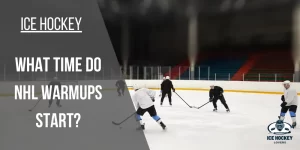Cross Checking Hockey: NHL’s Cross Checking Rule Explained!
Ice hockey is a thrilling and dynamic sport that captivates fans worldwide with its fast-paced action and physicality. One aspect of the game that has gained attention over the years is cross checking.
In this comprehensive guide, we will delve into the intricacies of cross checking in ice hockey, exploring its definition, rules, penalties, and the impact it has on the game.
Table of Contents
What is Cross Checking in Hockey?
Cross checking is a penalty in hockey that occurs when a player forcefully checks an opponent with the shaft of their stick between two hands. It is a dangerous move that can result in severe injury and is strictly prohibited in the sport.
To perform a cross-check, a player holds their stick with one hand at the top and the other about halfway down the shaft then pushes or shoves the opponent forcefully. The contact usually occurs across the body, hence the name “cross” checking.
Cross-checking is a major penalty in hockey, which means the offending player must sit in the penalty box for five minutes. If the player’s team scores during this time, they can return to the ice. However, if the opposing team scores multiple times during this penalty, the player must remain in the box for five minutes.
Video Example of Cross Checking
In the video, you can see a player from the Avalanche team (wearing the dark jersey) hitting a player from the Lightning team (wearing the white jersey) from behind. The Avalanche player holds his stick with both hands and forcefully pushes the Lightning player into the boards. What makes it worse is that this happens after the Lightning player passes the puck to someone else. Because of this action, the Avalanche player receives a five-minute penalty for cross-checking.
Official NHL Cross-Checking Rule Text (Rule 59)
The act of using the middle part of a stick, held between both hands, to forcefully stop an opponent, is known as checking.
Rules and Penalties
The National Hockey League (NHL) and other governing bodies have established specific rules and regulations to govern cross checking to maintain player safety and ensure fair play. Let’s take a closer look at these rules:
- Illegal Contact: Cross checking involves contacting an opponent using a hockey stick. However, if the contact is deemed excessive or done with unnecessary force, it can result in a penalty.
- Location of Contact: The NHL defines the target area for cross checking as the back of an opponent above the waist. Striking an opponent in this area is considered an infraction. It is important to note that cross checking in front of the net or away from the puck can also result in penalties.
- Intentional vs. Incidental: The intent behind the act of cross checking plays a significant role in determining the severity of the penalty. If the cross checking is deemed intentional, the player may face more severe consequences than when the cross check was accidental or incidental.
- The severity of Penalty: Depending on the severity of the cross check, referees can assess penalties ranging from a minor penalty, which leads to a two-minute power play for the opposing team, to major penalties, which can result in a player’s ejection from the game.
The Impact of Cross Checking
Cross checking plays a significant role in shaping the dynamics of ice hockey games. It can affect both offensive and defensive strategies, and its presence or absence can sway the outcome of a match. Here are some key points to consider:
- Defensive Strategy: Cross checking can be used by defensemen to disrupt the opposing team’s offensive plays. By effectively using their sticks to impede the progress of attacking players, defenders can buy time for their team to regroup or regain possession of the puck.
- Net-front Battles: Cross checking is often seen in front of the net, where players engage in physical battles to gain positioning and obstruct the opposing team’s attempts to score. These battles can become intense as players aim to create space for their teammates or prevent the opposition from establishing a solid offensive presence.
- Player Safety: As mentioned earlier, cross checking can lead to severe injuries if not properly controlled. The enforcement of rules and penalties related to cross checking helps safeguard the well-being of players and maintain the integrity of the game.
Conclusion
Cross checking, while a controversial aspect of ice hockey, remains an integral part of the game. Understanding its rules, penalties, and impact gives players, officials, and fans a comprehensive perspective on this play. By prioritizing player safety, enforcing the rules, and promoting alternative strategies, ice hockey can continue to thrive while ensuring a competitive and safe environment.

Who is Austin Taylor?
Meet Austin Taylor, your go-to source for everything ice hockey! With a passion for the sport that’s as deep as the ice itself, Austin Taylor brings you concise, expert insights and nitty-gritty details on all things hockey. From gear reviews to strategy breakdowns, Austin Taylor is your trusted guide to navigating the exhilarating world of ice hockey. Get ready to lace up your skates and dive into the game with Austin Taylor as your ultimate companion.



